Trinidad und Tobago |
|
| Übersicht – Contents: | |
Trinidad und Tobago |
|
| Übersicht – Contents: | |
Flaggen – Flags: |
|
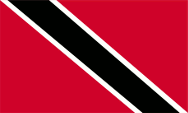 |
seit/since 1962, National- und Staatsflagge – national and state flag, Seitenverhältnis – ratio = 3:5, Quelle/Source, nach/by: Flags of the World |
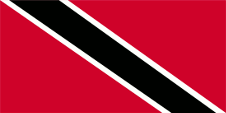 |
Handelsflagge und Staatsflagge zur See – merchant flag and state flag at sea, Seitenverhältnis – ratio = 1:2, Quelle/Source, nach/by: Flags of the World |
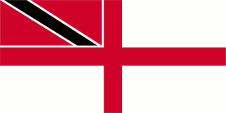 |
Marineflagge – naval flag, Seitenverhältnis – ratio = 1:2, Quelle/Source, nach/by: Flags of the World |
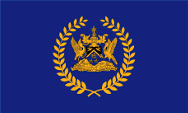 |
Flagge des Präsidenten – flag ot the President, Seitenverhältnis – ratio = 3:5, Quelle/Source, nach/by: TriniPosseStar, CC BY-SA 3.0, via Wikimedia Commons |
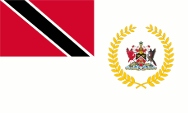 |
Flagge des Premierministers – flag of the Prime Minister, Seitenverhältnis – ratio = 3:5, Quelle/Source, nach/by: Prez001, CC BY-SA 3.0, via Wikimedia Commons |
historische Flaggen – historical Flags: |
|
 |
1889–1962, Union Flag → quasi Nationalflagge, Flagge Großbritanniens – flag of United Kingdom, Seitenverhältnis – ratio = 1:2, Quelle/Source, nach/by: Flags of the World   |
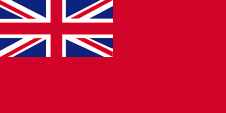 |
1889–1962, |
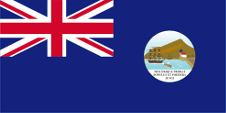 |
1889–1958, Flagge der Regierung (Staatsflagge) – flag of the government (state flag), Seitenverhältnis – ratio = 1:2, Quelle/Source, nach/by: Flags of the World |
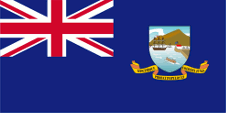 |
1958–1962, Flagge der Regierung (Staatsflagge) – flag of the government (state flag), Seitenverhältnis – ratio = 1:2, Quelle/Source, nach/by: Flags of the World |
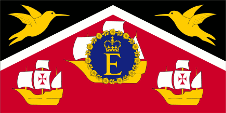 |
1962–1976, Flagge der Königin – flag of the Queen, Seitenverhältnis – ratio = 1:2, Quelle/Source, nach/by: Flags of the World |
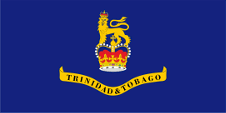 |
1962–1976, Flagge des Generalgouverneurs – flag of the Governor General, Seitenverhältnis – ratio = 1:2, Quelle/Source, nach/by: Flags of the World |
|
|
|
|
Flaggen von/flags of Trinidad ← hier klicken/click here Flaggen von/flags of Tobago ← hier klicken/click here |
|
|
|
|
|
|
|
Westindische Föderation – Federation of the West Indies (1958–1962): |
|
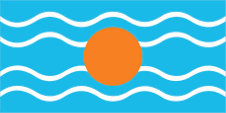 |
Flagge der Westindischen Föderation – flag of the Federation of the West Indies, Seitenverhältnis – ratio 1:2, Quelle/Source, nach/by: Flags of the World |
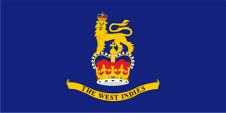 |
Flagge des Generalgouverneurs – flag of the Governor General, Seitenverhältnis – ratio 1:2, Quelle/Source, nach/by: Flags of the World |
| Die Flagge von Trinidad und Tobago wurde am 31.08.1962 anlässlich der Unabhängigkeit angenommen und erstmals offiziell gehisst. Sie zeigt ein rotes Grundtuch mit einem weißgesäumten schwarzen Schrägbalken von links oben nach rechts unten. Die Farbe Rot symbolisiert den Mut und die Lebenskraft des Volkes, aber auch die Kraft und Wärme der Sonne. Die Farbe Weiß steht für das Wasser des Ozeans, aber auch für die Reinheit der nationalen Bestrebungen und für die Emanzipation. Schwarz ist hier die Symbolfarbe für Stärke, für die nationale Einheit, für Tatkraft, Leistungsfähigkeit und Reichtum. Die in den meisten sorgfältigen, mehrfarbigen Reproduktionen der Flaggen von Trinidad und Tobago gezeigten Farben (teilweise auch im Wappen), lassen die Vermutung zu, dass sich Trinidad und Tobago bei den Farben und Fartönen traditionell am britischen Farbsystem orientiert, also das Farbsystem des Britischen Verteidigungsministeriums gültig ist. Das sieht vor, für Rot = Pantone 186 c, für Königsblau = Pantone 280 c und für Tiefgelb = Pantone 116 c. Die Flagge des Präsidenten ist blau und zeigt in der Mitte das Staatswappen in Gold, umgeben von einem goldenen Kranz. Die Flagge des Premierministers ist weiß und zeigt in der Oberecke die Nationalflagge und im fliegenden Ende das Staatswappen umgeben von einem goldenen Kranz. Die ehemalige Flagge der Königin zeigte zwischen 1962 und 1976 das Bild des Wappenschildes von Trinidad und Tobago mit dem persönlichen Emblem der Königin der Mitte. Die Flagge wurde mit der Einführung der Republik abgeschafft. In der sehr bewegten Geschichte der beiden Inseln wechselten deren Besitzer oft, und damit die hier verwendeten Flaggen. Zuletzt hatte sich Großbritannien im jahre 1803 den Besitz beider Inseln gesichert, so das ab jenem Jahr die Flagge von Großbritannien unangefochten über der Insel wehte. An Land, bis 1864 auch zur See, repräsentierten der einzelne Bürger und auch die Behörden ihren Status als Bürger oder Organe des United Kingdom, durch die Verwendung des Union Jack, "Union Flag" genannt. Großbritannien hatte in Jahr 1864 ein Flaggensystem eingeführt, in dem: • Kriegsschiffe einen sogenannten "White Ensign" (Marineflagge), eine weiße Flagge oft mit durchgehendem roten Georgskreuz und mit dem Union Jack in der Oberecke, • Handelsschiffe einen "Red Ensign" (auch "Civil Ensign" → Bürgerflagge genannt, die eigentl. Handelsflagge), eine rote Flagge mit dem Union Jack in der Oberecke, und • Dienstschiffe einen "Blue Ensign" (Regierungsflagge → die eigentliche Staatsflagge), eine blaue Flagge mit dem Union Jack in der Oberecke führten. Seit 1865 durften Schiffe von Kolonialregierungen einen Blue Ensign mit einem Badge (Abzeichen) im fliegenden Ende verwenden. Für alle anderen Zwecke war ab diesem Zeitpunkt an Land ausschließlich der britische Union Jack zu verwenden und zur See die übliche rote britische Handelsflagge, der "Red Ensign". Wenn die britische Admiralität der Kolonie die entsprechende Erlaubnis erteilt hatte, durften Handelsschiffe und private Seeleute dieser Kolonien einen Red Ensign mit dem Bagde führen. Dies war für Trinidad und Tobago nicht der Fall. Die jeweiligen Regierungen sollten entsprechende Bagdes zur Verfügung stellen. Ein solches Badge war oft eine auf einer Scheibe platzierte regionale landschaftliche Darstellung, zeigte oft Schiffe, historische Begebenheiten oder konnte auch nur eine Art Logo sein. Sehr oft zeigte ein Badge zusätzlich den Namen des Landes oder auch einen Wahlspruch. Einige Besitzungen hatten aber auch schon von Anfang an ein Wappen, bzw. erhielten über die Jahre eine eigenes Wappen und das Badge wurde abgeschafft. Um ein weitgehend einheitliches Erscheinungsbild im fliegenden Ende der Flaggen zu gewährleisten, wurden Wappen und auch andere Symbole auf einer weißen Scheibe in der Größe der früheren Badges dargestellt. Es gab hier aber auch Ausnahmen, denn einige Kolonien verwendeten diese weiße Scheibe nicht, und platzierten ihr Wappen oder auch nur das Wappenschild - manchmal auch vergrößert - direkt auf das Flaggentuch. Schon in den 40-er Jahren wurde dazu übergegangen die weißen Scheiben zu entfernen und das Wappen direkt zu platzieren oder vergrößert dazustellen. Dieser Umstellungsprozess erfolgte allmählich, nirgendwo gleichzeitig und vollständig. In einigen britischen Besitzungen sind bis heute Flaggen mit der weißen Scheibe in Gebrauch, in anderen nicht mehr und in einigen Gebieten gibt es beide Varianten nebeneinander. Ab 1875 verwendete die Regierung von Trinidad, als britische Kolonie, die blaue britische Dienstflagge (Blue Ensign) mit einem Badge im wehenden Teil der Flagge. Das 1875 eingeführte Badge zeigte eine gebirgige Küstenlandschaft mit einer Küstenbefestigung. Auf der Küstenbefestigung weht eine Flagge, ein Blue Ensign. In den Küstengewässern liegt ein britisches Kriegsschiff mit gerefften Segeln auf der Reede. Im Vordergrund ist ein Ruderboot zu sehen. Der untere Teil der Scheibe zeigt das Motto der Insel auf einer weißen Fläche: "Miscerique probat populus et foedera jungi" → "Es hat sich bewährt, die Völker zu mischen und sie in Einheit zu verbinden". Im Jahre 1889 wurde Tobago der Verwaltung durch Trinidad unterstellt, das Badge wurde für Trinidad und Tobago unverändert bis 1958 beibehalten. Gleichzeitig war die Kolonie von 1958 bis 1962 Teil der Britischen Kolonie "Westindische Föderation", ein Versuch die Verwaltung zusammenzufassen und auch den Unabhängigkeitsbestrebungen der zugehörigen Inseln und Kolonien entgegenzuwirken. Die Flagge der "Westindische Föderation" war ein hellblaues Flaggentuch mit vier waagerechten weißen Wellenlinien und einer goldenen Scheibe in der Mitte. Sie symbolisierte die Sonne über der Karibischen See. Über den Farbton des Blau ist man sich im Zweifel, es wird oft das übliche Britische Heraldikblau angenommen. Eine Zeitgenössische Beschreibung nennt jedoch ein "kaiserliches Blau" was Hellblau wäre und auch viele zeitgenössische Drucke zeigen dieses helle Blau. In diesem Zusammenhang wurde 1958 auch das Badge abgeschafft und das Bild des Badges auf einen Wappenschild übertragen und auch so auf dem "Blue Ensign", der Flagge der Regierung verwendet. Das Motto der Kolonie erschien in auf einem goldenen Spruchband unterhalb des Wappenschilds. |
The flag of Trinidad and Tobago was adopted and officially hoisted for the first time on 31st of August in 1962, on the occasion of independence. It shows a red base bunting with a white-lined black slanting bar from top left to bottom right.
The colour red symbolizes the courage and vitality of the people, but also the power and warmth of the sun. The colour white represents the water of the ocean, but also the purity of national aspirations and emancipation. Black is the symbolic colour for strength, for national unity, for energy, performance and wealth. The colours shown in most of the careful, multi-coloured reproductions of the flags of Trinidad and Tobago (sometimes also in the coat of arms) suggest that Trinidad and Tobago's colours and colour-shades are traditionally based on the British colour system, so that the British Ministry of Defense colour system would be used. This purports for red = Pantone 186 c, for royal blue = Pantone 280 c and for deep yellow = Pantone 116 c. The presidential flag is blue and features the national coat of arms in gold in the center, surrounded by a golden wreath. The Prime Minister's flag is white and shows the national flag in the upper corner and the national coat of arms surrounded by a golden wreath in the flying end. The Queen's former flag between 1962 and 1976 featured the image of the heraldic shield of Trinidad and Tobago with the personal emblem of the Queen in the center. The flag was abolished with the introduction of the Republic. During the very eventful history of the two islands, their owners changed often, and with them the flags used here. United Kingdom last secured ownership of the both islands in 1803, so that from that year on the flag of United Kingdom flew unchallenged over the island. On land, and until 1864 also at sea, the individual citizen and also the authorities represented their status as citizens or organs of the United Kingdom by the use of the Union Jack, called the "Union Flag". United Kingdom had introduced a flag system in 1864 in which: • War ships use a so-called "White Ensign" (naval flag), a white flag often with a red St. George's cross throughout and with the Union Jack in the upper corner, • Merchant ships use a so-called "Red Ensign" (also called "Civil Ensign" → citizen flag, the actual merchant flag), a red flag with the Union Jack in the upper corner, and • Governmental ships use a "Blue Ensign" (flag of the government → the actual state flag), a blue flag with the Union Jack in the upper orner. Since 1865, colonial government ships were permitted to use a Blue Ensign with a badge in the flying end. From this point on, only the British Union Jack was to be used for all other purposes on land and the usual red British merchant flag, the "Red Ensign", at sea. If the British Admiralty had granted the appropriate permission to one colony, merchant ships and private sailors from this colony were allowed to use a Red Ensign with the Bagde. This was not the case for Trinidad and Tobago. The respective governments should provide appropriate bagdes. Such a badge was often a regional landscape representation placed on a disk, often showed ships, historical events or could just be a kind of logo. Very often a badge also showed the name of the country or a motto. However, some possessions had a coat of arms right from the start, or received their own coat of arms over the years and the badge was abolished. In order to ensure a largely uniform appearance in the flying end of the flags, coats of arms and other symbols were displayed on a white disk the same size as the earlier badges. But there were exceptions here, as some colonies did not use this white disk and placed their coat of arms or just the shield – sometimes enlarged – directly on the flag cloth. As early as the 1940s, the white discs were removed and the coat of arms was placed directly or enlarged. This transition process occurred gradually, never simultaneously and completely. In some British possessions flags with the white disc are still in use, in others they are no longer used and in some areas both variants exist side by side. From 1875, the government of Trinidad, as a British colony, used the blue British official flag (Blue Ensign) with a badge in the waving part of the flag. The badge, introduced in 1875, showed a mountainous coastal landscape with a coastal fortification. A flag, a Blue Ensign, flies on the coastal fortifications. A British warship with reefed sails lies in the roadstead in the coastal waters. A rowing boat can be seen in the foreground. The lower part of the disc shows the island's motto on a white surface: "Miscerique probat populus et foedera jungle" → "It has proven successful to mix the peoples and unite them in unity". In 1889 Tobago was placed under the administration of Trinidad and the badge was retained unchanged for Trinidad and Tobago until 1958. At the same time, the colony was part of the British colony "West Indian Federation" from 1958 to 1962, an attempt to consolidate the administration and also to counteract the independence efforts of the associated islands and colonies. The flag of the "West Indian Federation" was a light blue flag with four horizontal white wavy lines and a golden disc in the middle. It symbolized the sun over the Caribbean Sea. There is some doubt about the color of the blue; it is often assumed to be the usual British heraldry blue. However, a contemporary description calls it an "imperial blue" which would be light blue and many contemporary prints also show this light blue. In this context, the badge was abolished in 1958 and the image of the badge was transferred to an escutcheon and also used on the "Blue Ensign", the governmental flag. The colony's motto appeared on a golden banner below the escutcheon. |
| Quelle/Source: Die Welt der Flaggen, World Statesmen, Flags of the World, Flaggen Wappen Hymnen, Flaggen-Atlas Erde, Volker Preuß | |
Wappen – Coat of Arms: |
|
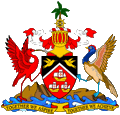 |
seit/since 1962, Wappen von Trinidad und Tobago – coat of arms of Trinidad and Tobago, Quelle/Source: Corel Draw 4 |
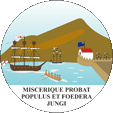 |
1889–1958, Emblem von Trinidad und Tobago – Badge of Trinidad and Tobago, Quelle/Source, nach/by: Flags of the World |
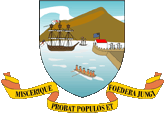 |
1958–1962, Emblem von Trinidad und Tobago – Badge of Trinidad and Tobago, Quelle/Source, nach/by: Flags of the World |
| Das Staatswappen wurde am 09.08.1963 von Königin Elisabeth II. offiziell verliehen und wie die Flagge am 31.08.1962 anlässlich der Unabhängigkeit eingeführt. Der Wappenschild zeigt oben Schwarz und unten Rot, geteilt durch einen silbernen Sparren. Im schwarzen Feld zwei Kolibris, sie stehen für die beiden Inseln und deren Naturreichtümer. Im roten Feld drei Karavellen, es sind die Schiffe des Kolumbus. Sie stehen für das Meer welche beide Inseln trennt und verbindet. Schildhalter sind links ein Scharlach-Ibis (er repräsentiert Trinidad) und rechts ein Cocorico (er repräsentiert Tobago). Oberhalb des Schildes ein goldener Helm mit weiß-roten Decken und einem weiß-roten Wulst. Ganz oben Kleinode: ein hölzernes Steuerrad und eine Palme. Der Schild ruht auf einem Sockel, der eine Insellandschaft darstellt. Ganz unten ein goldenes Spruchband mit dem Motto des Landes: "Toghether we aspire - toghether we achieve" → "Gemeinsam bemühen wir uns – gemeinsam sind wir erfolgreich". Das 1875 eingeführte Badge zeigte eine gebirgige Küstenlandschaft mit einer Küstenbefestigung. Auf der Küstenbefestigung weht eine Flagge, ein Blue Ensign. In den Küstengewässern liegt ein britisches Kriegsschiff mit gerefften Segeln auf der Reede. Im Vordergrund ist ein Ruderboot zu sehen. Der untere Teil der Scheibe zeigt das Motto der Insel auf einer weißen Fläche: "Miscerique probat populus et foedera jungi" → "Es hat sich bewährt, die Völker zu mischen und sie in Einheit zu verbinden". Im Jahre 1889 wurde Tobago der Verwaltung durch Trinidad unterstellt, das Badge wurde für Trinidad und Tobago unverändert bis 1958 beibehalten. 1958 wurde das Badge abgeschafft und das Bild des Badges auf einen Wappenschild übertragen. Das Motto der Kolonie erschien in auf einem goldenen Spruchband unterhalb des Wappenschilds. |
The national coat of arms was officially awarded by Queen Elizabeth II. on 9th of August in 1963 and, like the flag, was it introduced on 31st of August in 1962 on the occasion of independence. The coat of arms shows black at the top and red at the bottom, divided by a silver chevron. In the black field there are two hummingbirds, they represent the two islands and their natural riches. In the red field there are three caravels, they are Columbus's ships. They represent the sea that separates and connects both islands. Shield holders are a Scarlet Ibis on the left (representing Trinidad) and a Cocorico on the right (representing Tobago). Above the shield is a golden helmet with white and red covers and a white and red bulge. At the top there are gems: a wooden steering wheel and a palm tree. The shield rests on a base depicting an island landscape. At the bottom there is a golden banner with the country's motto: "Toghether we aspire - together we achieve" → "Together we strive - together we are successful". The badge, introduced in 1875, showed a mountainous coastal landscape with a coastal fortification. A flag, a Blue Ensign, flies on the coastal fortifications. A British warship with reefed sails lies in the roadstead in the coastal waters. A rowing boat can be seen in the foreground. The lower part of the disc shows the island's motto on a white surface: "Miscerique probat populus et foedera jungle" → "It has proven successful to mix the peoples and unite them in unity". In 1889 Tobago was placed under the administration of Trinidad and the badge was retained unchanged for Trinidad and Tobago until 1958. The badge was abolished in 1958 and the image of the badge was transferred to an escutcheon. The colony's motto appeared on a golden banner below the escutcheon. |
| Quelle/Source: Die Welt der Flaggen, Flags of the World, Flaggen Wappen Hymnen, Volker Preuß | |
Flugzeugkokarde – aircraft roundel: |
|
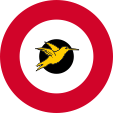 |
Flugzeugkokarde – aircraft roundel Quelle/Source, nach/by: Wikipedia (EN) |
Landkarte – Map: |
Lage – Position: |
Landkarte des Landes – Map of the Country: |
|
|
| Zahlen und Fakten – Numbers and Facts: | |
|
|
|
|
|
|
|
|
|
|
|
|
|
|
|
|
|
|
|
Geschichte von Trinidad ← hier klicken Geschichte von Tobago ← hier klicken |
1802 · Spanien tritt Trinidad an Großbritannien ab, die Insel wird britische Kronkolonie |
|
History of Trinidad ← click here History of Tobago ← click here |
|
1st of January 1899 · Trinidad becomes united with Tobago to the
colony of Trinidad and Tobago 1939–1945 · Second World War, the islands become build up to the bigest allied military base in the Caribbean Sea 1958–1962 · Trinidad and Tobago is a part of the Federation of the West Indies 1959 · United Kingdom grants inner self administration 31st of August 1962 · United Kingdom grants independence in the framework of the Commonwealth of Nations, the country becomes a constitutional monarchy under the British monarch as chief of state 1970 · agitations 1972 · state of emergency 1st od August 1976 · Trinidad and Tobago becomes a republic, but remains in the Commonwealth of Nations 1980 · Tobago gets partial inner self administration 1987 · Tobago gets autonomy |
| Quelle/Source: Wikipedia (EN), World Statesmen, Volker Preuß |
| Als der spanische Seefahrer Christoph Kolumbus die Insel 1498 entdeckte, nennt er sie "Trinidad", wegen der drei eigentümlichen Bergspitzen in der Silhouette der Insel. Trinidad heißt Trinität bzw. Dreifaltigkeit. | As the Spanish seafarer Christoph Columbus discovered the island in 1498 he named it "Trinidad", because of the three characteristic mountain peaks in the silhouette of the island. Trinidad means Trinity. |
| Auch Tobago wurde im Jahre 1498 durch den spanischen Seefahrer Christoph Kolumbus entdeckt. Er nannte sie "Bella Forma" (die Wohlgeformte), nach anderen Quellen "Isla de la Asunción" (Himmelfahrtsinsel). Nur wenige Jahre später wurde sie "Isla La Magdalena" genannt (Magdaleneninsel). Später hatte die Insel viele Namen, je nach ihrem jeweiligen Besitzer. So auch "Nieuw Walcheren" oder "Neukurland". Die Franzosen und Briten nannten sie "Tobago". Der Name geht auf das Wort Tabak zurück. Angeblich geht auch der Ursprung dieses Inselnamens auf Kolumbus zurück, weil er beobachtet hatte, dass die Kariben Tobacco-Blätter in einer Tambaku rauchten, und er habe der Insel darauf hin diesen Namen gegeben. | Tobago
was also discovered by the Spanish seafarer Christoph Columbus in the year
1498. He named it "Bella Forma" (the Wellshaped), by other sources "Isla de
la Asunción" (Ascension Island). Only some years later it was named "Isla La
Magdalena" (Magdalena Island). Later the island had many names, according to
its respective owner. So even "Nieuw Walcheren" or "Neukurland". The French and the British
called it "Tobago". This name has its roots in the word Tobacco. Otensibly
even that island's name has its roots in Columbus, because he watched that
the Cariben smoking Tobacco-Leafs in a Tambaku, and he
used this name for the island. |
| Quelle/Source: Handbuch der geographischen Namen, World Statesmen, etymonline.com, Volker Preuß | |